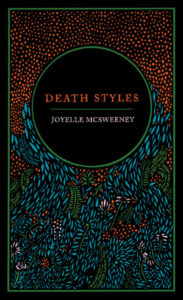
Style As Survival: On Writing After Death
Joyelle McSweeney Explores the Creative Process That Grief Provokes
“After the combat of eagles comes the combat of octopuses […] The hideous flower, the outlined flower, revolves its black petals in the mad flesh of the sun. Where is the source? Where the remedy? When will the economy finally change its ways?”
–René Char writing under his Resistance codename, Hypnos
*Article continues after advertisement“Why not understand life for what it is? Why not force life to understand itself?”
–Amelia Rosselli, Obtuse Diary
*
1. After the baby died, it was not the case that I could not write.
2. When we strolled to the hospital for her birth on a warm September day, it was still summer, but when we sped away from a different hospital in a different city two weeks later, it was October, and Fall. In the meantime she was born; could not breathe; failed the X-ray; spun away through the air like a mini-goddess in her heliocopt; she was intubated and exsanguinated, reoxygenated, revived; then, as steeply, she declined. I stumbled down the corridors—my husband ripped out the infant carseat, we drove home with it in the trunk—along the highway, autumn sun bent low to pick out every dying weed—so every dying weed was made to bear her mask of light.
I wrote myself back to writing, I wrote myself through each day. I wrote myself, however ambivalently, back to life.
3. After the baby died, it was not the case that I could not write. Spring pushed me to a rage, I wrote in counter-torrent, but nothing could make the currents reverse, bring my lost coin back up the drain. So I slammed shut my laptop, right there in the dumb cafe. I forbade myself to write.
And like all poet’s curses, it held.
4. For two years after the baby died, I could not write. I could not get up from under the stone of myself or haul myself back up the well. Then one day I was reading or trying to read (I also could not read) Malina by Ingeborg Bachmann, the post-war Austrian poet and novelist, lover and correspondent of Paul Celan, who died of complications of smoking in bed. Malina is a novel of rage and ambivalence, a bildungsroman and a künstlerroman, in which the girl-author immures herself in her own novel’s stylized walls like Poe’s black cat and pulls the moonlight up after her. The girl-author prefers imagining herself as posthumous, I think, rather than in terms of conventional survival—which frees her, as well, from patriarchy’s various mandatory plots (natalism, nationalism, consumerism, sexual availability, daughterly obedience, history). Through the intensity of its style and the delirium of its structure, the girl-author becomes triumphantly inseparable from her own art:
I propagate myself with words and also propagate Ivan, I beget a new lineage, my union with Ivan brings that which is willed by God into the world.
Firebirds
Azurite
Plunging flames.
Drops of jade.
Malina is part of an unfinished trilogy called Death Styles, a work that, in some inside-out way, you can glimpse the girl-narrator, Bachmann’s double, writing from inside this one. In one feverish scene, she’s left the pages around where her lover, Ivan, can find them, so we readers can find them too: “Merrily he takes one and reads: DEATHSTYLES.”
Death Styles, I thought. Thank you, Ingeborg Bachmann. Death Styles. It is a signal to me from the cat in the walls. A golden coin up the drain of my brain.
5. I got to work. I had a title. Now I needed to write the book. Creation ex nihilo. Well, if God had done it, so could I. A girl-author, a Lady God. What would be Death Styles? Death Styles would not be a what but a way. Remembering Kathy Acker’s maxim—”If it can’t be done, but it must be done, then it will be done, by magic”—I set myself three (magic) rules: 1) I had to write daily 2) I had to accept any inspiration that came to me, however unlikely and 3) I had to write until the inspiration was totally exhausted.
In this way, I wrote Death Styles. I wrote myself back to writing, I wrote myself through each day. I wrote myself, however ambivalently, back to life.
6. I was extremely surprised by the style icons who appeared to guide the writing of Death Styles. The first was a skunk who cut diagonally across some rich guy’s lawn; this was a memory: its tail like a solar canopy under which it seemed to glide like tomb paintings of Egyptian lords on their way to the afterlife, a cut in time as sharp as shears in fabric of the sky. The vision of it froze me in place, in time, and the poem arranged itself in such clear sightlines, crystalline. So much for Death Style #1. The next icon was a Marimekko robe I wore to walk the dog one desperate day. I was so undone by grief I had to wrap myself in what (for me) is luxury to even move. To anyone who saw me, I was the sad neighbor lady walking the dog in her robe. I guess you could say I was the sad goddess in her mantle strapped to the prow. Follow your leader.
I learned that concern for style is not secondary to concern for survival.
Thus glamoured, carried forward by glamour, I was soon also visited by killer queens from Greek tragedy—Medea, who murdered her children but also carried them away in a spangled dragon carriage, and Clytemnestra, who murdered her man in his bath having snared him in rich robes. Leonard Cohen, Mary Magdalene, Diana Vreeland, and other glamorous and dubious figures. A Merganser duck whose white clock-face in profile remonstrated me and my shabby hoodie from the river. A Mickey Mouse watch who stuffed his own gloved hands in his mouth. And, several times, River Phoenix, whose name now sounds like a doused and drowned god, who rose up from his nest of vipers and lifting a Bic lighter relit, like the skunk, his solar crest of hair. But he didn’t speak to me. Instead, to him alone I could say the final lines of the conclusive Death Style:
I was robbed
of something
by a god
and I’m going
to keep looking
until I find it.
For “conclusive,” read “convulsive.” Read, “convolvulus.” Lie down in the river. Dip your sieve in the river. Dip your kid there, by his ankle. Try again.
7. At the end of every fable you must tell what you learned. So here is what I learned from writing Death Styles. I learned that concern for style is not secondary to concern for survival. I learned that survival requires a style—and entails one. Style is the robe in which we wrap ourselves so we can stay on our feet, style is gleaming shears to cut the unbearably lovely fabric of the sky, style is the gust and the hush, with style we bear the glare of the duck, go sideways like the skunk, glide on the thinnest of skeins to the next hour, the next day. Style is a recognition of things which are like us, and which we would like to be like. In this sense, style is simulacra—the copy, the double, that allows art to be made, that is Art, both a display and self-encryption that allows us to survive life’s plot.
8. Finally, I learned that style is also political. I think of René Char, who ran a Resistance cell in the French countryside under the nom-de-guerre Hypnos, the Greek god of Sleep, twin of Death. As Hypnos, Char kept a wartime journal of vignettes and maxims in the style of Heraclitus, as if writing at once from the beginning and the end of time, as if style could open a twin-region, as broad and marvelous as Death’s, into which we might cross and survive. I think of Dolores Dorantes’s sybilline book in which the victims of femicide along the US-Mexico border rise in plural unison to refuse their own extermination. That book is called Estilo—Style. And I think of the Palestinian man who helped pull a young girl from the ruins of her bombed home in Gaza this past November. When asked by the child, “Uncle, am I going to the cemetery?”, he replies, “No, my darling, you are alive and as beautiful as the moon.” With this figurative language, he not only tenderly assures her that she is, in fact, alive; he writes her into their shared poem of cultural survival.
9. And I learned, if we cannot survive, then style is what survives us.
10. Well, that’s how I did it.
That’s how I wrote myself back to life.
I had written Death Styles.
And I would survive.
I was cured, alright.
__________________________________

Death Styles by Joyelle McSweeney is available from Nightboat Books.
Joyelle McSweeney
Joyelle McSweeney is the author of eight books, most recently the play Dead Youth, or, the Leaks (Litmus, 2014) and the critical book The Necropastoral: Poetry, Media, Occults (U. of Michigan Poets on Poetry Series, 2015). She co-edits the international press Action Books and teaches at Notre Dame.



















